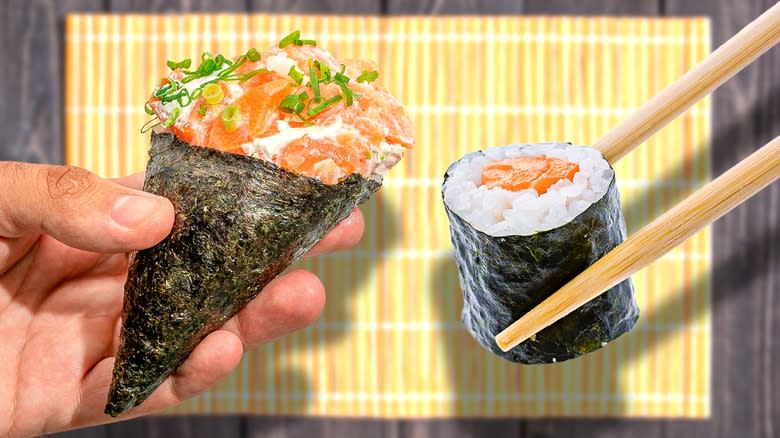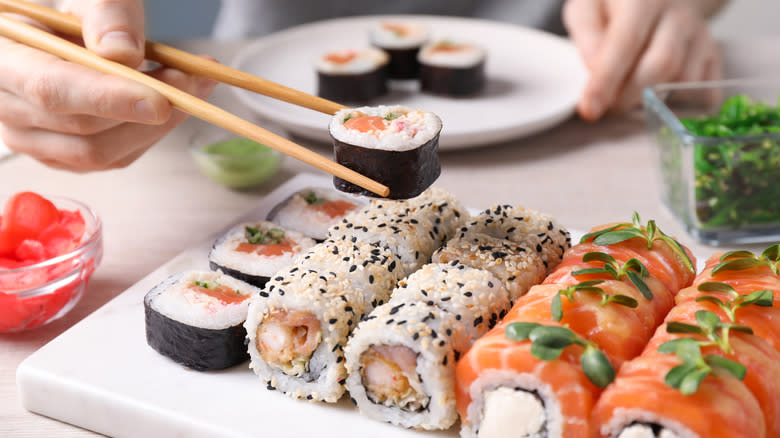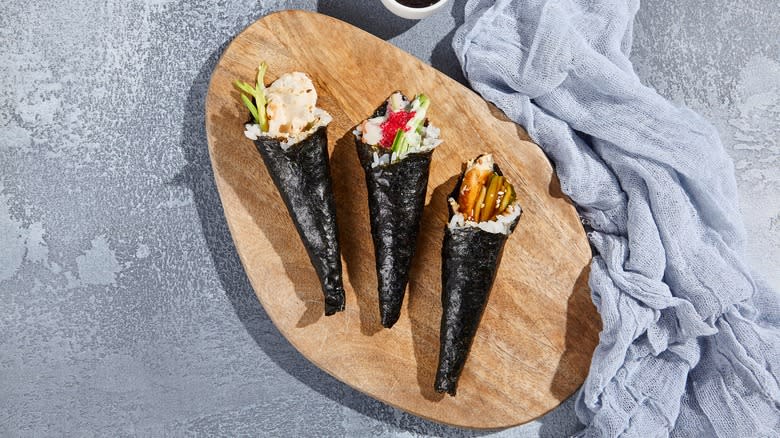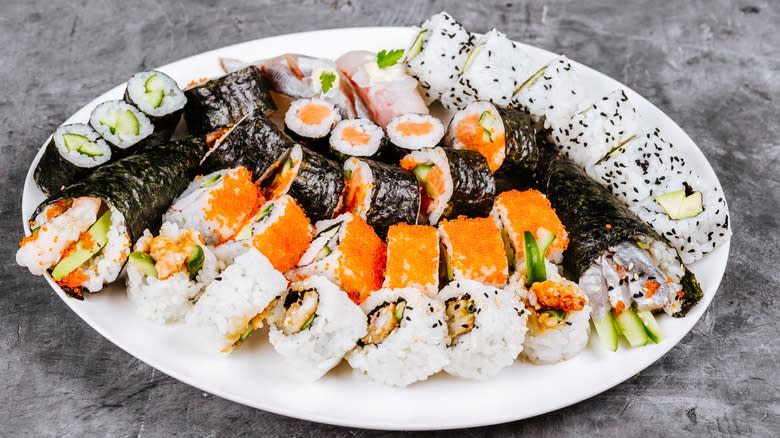The Simple Difference Between Maki And Temaki Sushi

The Japanese custom of serving morsels of fish with lightly seasoned rice has become increasingly popular around the world as we look for healthy ways to include more seafood in our diets. Sustainable, quality, sushi-grade fish is also now easier to source farther inland thanks to a combination of consumer demand and the growing list of companies that ship almost everywhere, so going out for sushi is more accessible than ever these days. Whether you're a sushi novice or a frequent visitor to your local sushi bar, understanding the traditional names on the menu is key to placing an order for exactly the bite you hope for.
Two sushi styles, maki and temaki, have similar names that might be easy to mix up, but you'll get a very different result if you happen to use the wrong word. Both of these types of sushi include rice, fish or vegetables, and crispy nori seaweed, but they're shaped differently. Maki sushi is rolled in a cylinder, sliced into discs, and is available in different versions: smaller, larger, and inside out. Temaki, also called hand-roll, is constructed by forming a cone shape with the nori wrapper. All of the rice, fish, vegetables, and seasonings are neatly contained inside.
Read more: 15 Different Ways To Cook Fish
What Is Maki Sushi

The term maki sushi means "rolled sushi," which is exactly what you should expect when you order this iconic Japanese food. The roll is crafted with a nori seaweed sheet defining its size and shape. Cooked and seasoned sushi rice is spread onto the nori, which is then rolled around a choice of fillings with the help of a flexible bamboo mat. Simple maki sushi has dark green nori as the outermost layer of the roll. If the rice-laden nori sheet is flipped upside down before the fillings are rolled inside, the roll is known as "uramaki," an inside-out roll featuring rice as the outside of each piece.
The other variations in maki sushi come from the amount of filling ingredients used, which determines the finished diameter of the roll. The smallest maki sushi (hosomaki) has just one thin central ingredient — think cucumber rolls. Adding a thicker middle with more ingredients yields the more typical "chumaki" size, which is the most common sushi bar maki selection — California rolls, for example. The largest rolls, futomaki, have yet more items rolled inside. A mix of colorful vegetables and unagi (broiled eel) is typical for this festive sushi.
What Is Temaki Sushi

Temaki, literally translated as hand-roll sushi, might be an unexpected form if you've only seen maki and nigiri sushi at your local sushi restaurant. This sushi can contain exactly the same delicious ingredients as any ordinary maki sushi. However, in this case, the nori is simply rolled into a loose cone shape with a decorative display of ingredients peeking out from the wide open end. There's no inside-out version because the cone is meant to be picked up in your hand, just like an ice cream cone, and devoured from top to bottom.
Temaki is not only eaten with hands but also created simply with hands — no rolling mat is needed to form the shape. That makes temaki a popular street food because it's easy to eat without chopsticks or condiments; everything is built right into the cone. For temaki, the crispness of the nori is key. You'll want to eat this sushi as soon as it's served to get the best texture when you bite through the layers.
Maki Sushi Has Many Variations

If you're a sushi lover, you'll be equally happy with temaki or any of the varied rolled maki sushi pieces that land on your table. You can eat both styles of sushi out of hand – no need for chopsticks for most sushi, although sticky inside-out uramaki may be more practical to pick up with chopsticks, especially when served with additional fish and sauce on top. The main difference between these similar forms of sushi is the simplicity of a hand roll shape compared with the range of sizes and innovative forms you'll find in maki sushi rolls.
For those who prefer not to eat raw seafood, you'll be pleased to know that many maki sushi rolls don't contain any raw fish at all. From the smallest-sized, totally vegetarian cucumber or avocado hosomaki to crispy tempura shrimp-filled maki rolls all the way to large, flavorful futomaki, it's easy to find a combination of ingredients to suit your taste whether you're a fan of simple hand rolls or the more creative maki roll choices.
Read the original article on Tasting Table.

